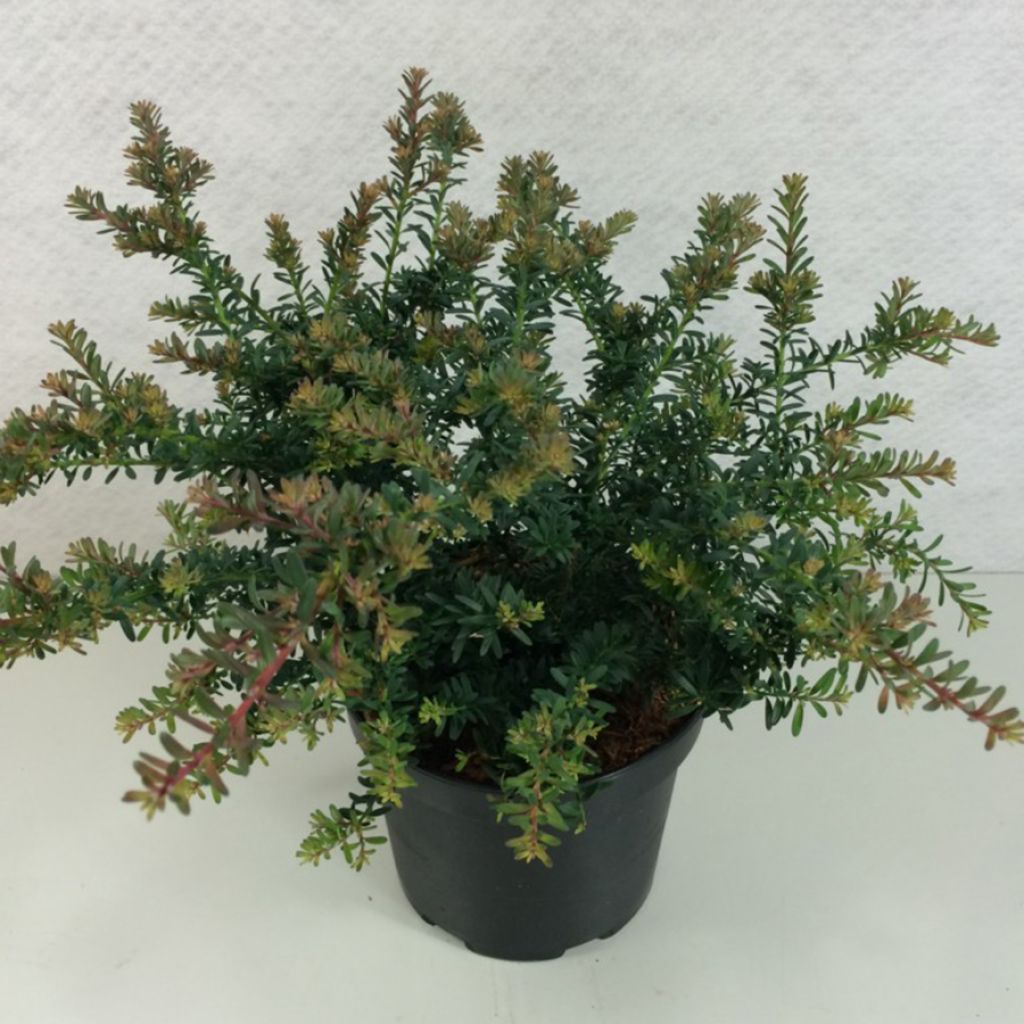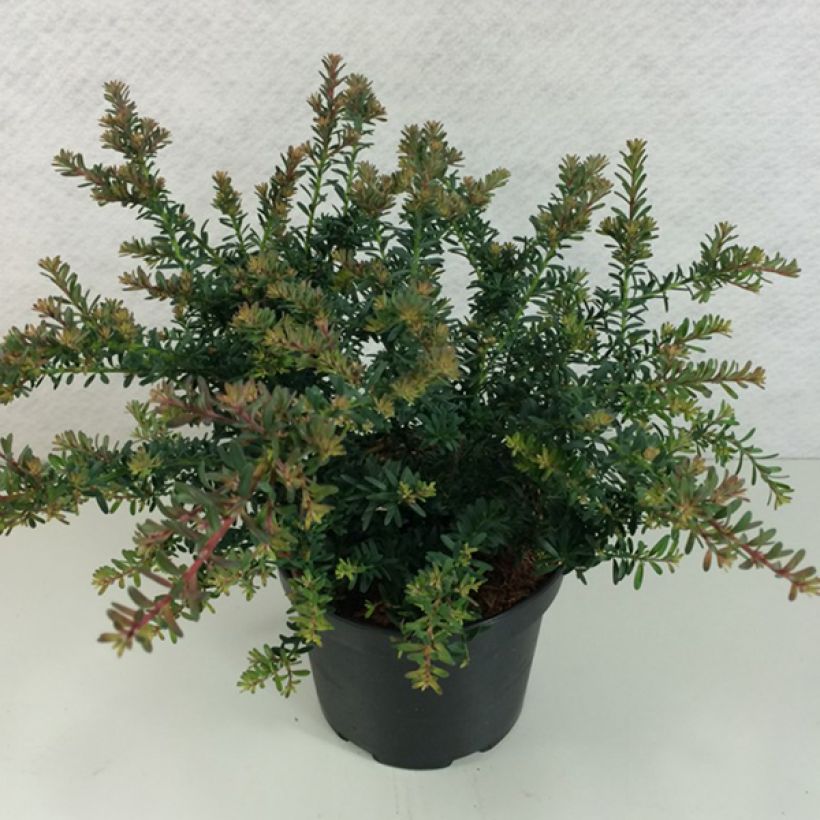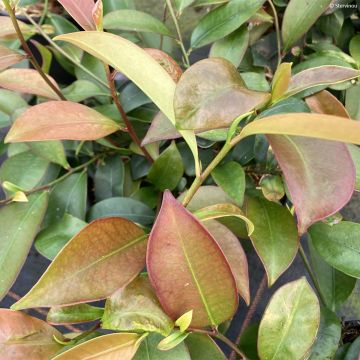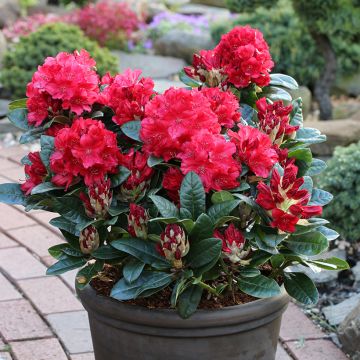

Podocarpus lawrencii Blue Gem
Podocarpus lawrencii Blue Gem
Podocarpus lawrencii Blue Gem
Mountain Plum-pine, Alpine Plum-pine, Podocarp
This item cannot be shipped to the selected country
Delivery charge from €6.90
More information
Delivery charge from €6.90
More information
Schedule delivery date,
and select date in basket
This plant carries a 24 months recovery warranty
More information
We guarantee the quality of our plants for a full growing cycle, and will replace at our expense any plant that fails to recover under normal climatic and planting conditions.
From €7.90 for pickup delivery and €6.90 for home delivery
Express home delivery from €8.90.
Does this plant fit my garden?
Set up your Plantfit profile →
Description
Forming a small bristly bush, with an upright to spreading habit, Podocarpus lawrencii 'Blue Gem' is a slightly frost-tender, but very attractive, Australian conifer. It displays magnificent blue foliage, composed of tiny leaves that create a fabulous contrast with its fleshy red berries. Its small, twisted branches are carried by a very short and knotty trunk, which is particularly interesting in a pot or rock garden. Its growth is quite slow, and it prefers cool, light, neutral to acidic soils. It requires full sun and a sheltered position.
Podocarpus lawrencii is an evergreen conifer of the Podocarpaceae family, native to all regions of Australia. In its natural environment, depending on its habitat, it will reach a height of 60 cm (24in) in the mountains, while in the plains it can grow up to 8 m (26ft) tall. It often forms living carpets, flattened on rocks and pruned by the wind. This slightly hardy species ,-7 to -12°C (19.4 to 10.4°F) requires good sunlight and a moist but well-drained soil.
The 'Blue Gem' variety, as its name suggests, differs from the wild species by its very small size, and by its beautiful blue foliage tinged with aqua green. Its habit is unusual, bushy and bristly, more or less upright or spreading, but always contorted, and influenced by cultivation conditions. Its growth is slow, so in the long run it will not exceed 1 to 2 m (3 to 7ft) in all directions. Its twisted branches are covered with small leaves that are 1 cm (1in) long, 2 to 3 mm (1in) wide, and sometimes turn red in winter due to the cold. It produces red berries that are 5 to 10 mm (1in) in diameter, which are loved by birds but toxic to many mammals (including humans).
Podocarpus lawrencii 'Blue Gem' will find its place in a small garden with a mild and humid climate, in a border or rock garden. It can be displayed as a rare and precious object in a large pot on the patio or balcony, which will protect it from the coldest winters. It works wonders in a Japanese garden, perfectly suited to the art of bonsai and goes well with large stones, geometric lines of pools, and architectural structures. It can be associated with grasses or sacred bamboos. The true geometric qualities of conifers naturally impose themselves in the design of a contemporary garden, which prefers the aesthetics of shapes, silhouettes, and textures to an array of flowers. These structural plants, enhance a border, mark pathways and decorate the patio or balcony, happily replacing trimmed boxwood or holly. The key is to play with volumes and colours.
Podocarpus lawrencii Blue Gem in pictures




Plant habit
Flowering
Foliage
Botanical data
Podocarpus
lawrencii
Blue Gem
Podocarpaceae
Mountain Plum-pine, Alpine Plum-pine, Podocarp
Cultivar or hybrid
Other Podocarpus
View all →Planting and care
The 'Blue Gem' Podocarpus can be planted from September to November and from February to June in well-drained, moist, even poor, neutral to slightly acidic soil. It dislikes heavy soils, soild that are too dry in summer, and scorching temperatures. Choose a sunny location sheltered from prevailing winds. Soak the root balls well before planting. Optionally, add organic matter at planting and water generously for the first two years, and during prolonged drought. You can apply a special conifer fertilizer every year in April and cultivate the soil in summer. This hardy conifer can be grown perfectly in a pot that can be stored in a cool, unheated area during winter. It does not need to be pruned.
Planting period
Intended location
Care
-
, onOrder confirmed
Reply from on Promesse de fleurs
Evergreen shrubs
Haven't found what you were looking for?
Hardiness is the lowest winter temperature a plant can endure without suffering serious damage or even dying. However, hardiness is affected by location (a sheltered area, such as a patio), protection (winter cover) and soil type (hardiness is improved by well-drained soil).

Photo Sharing Terms & Conditions
In order to encourage gardeners to interact and share their experiences, Promesse de fleurs offers various media enabling content to be uploaded onto its Site - in particular via the ‘Photo sharing’ module.
The User agrees to refrain from:
- Posting any content that is illegal, prejudicial, insulting, racist, inciteful to hatred, revisionist, contrary to public decency, that infringes on privacy or on the privacy rights of third parties, in particular the publicity rights of persons and goods, intellectual property rights, or the right to privacy.
- Submitting content on behalf of a third party;
- Impersonate the identity of a third party and/or publish any personal information about a third party;
In general, the User undertakes to refrain from any unethical behaviour.
All Content (in particular text, comments, files, images, photos, videos, creative works, etc.), which may be subject to property or intellectual property rights, image or other private rights, shall remain the property of the User, subject to the limited rights granted by the terms of the licence granted by Promesse de fleurs as stated below. Users are at liberty to publish or not to publish such Content on the Site, notably via the ‘Photo Sharing’ facility, and accept that this Content shall be made public and freely accessible, notably on the Internet.
Users further acknowledge, undertake to have ,and guarantee that they hold all necessary rights and permissions to publish such material on the Site, in particular with regard to the legislation in force pertaining to any privacy, property, intellectual property, image, or contractual rights, or rights of any other nature. By publishing such Content on the Site, Users acknowledge accepting full liability as publishers of the Content within the meaning of the law, and grant Promesse de fleurs, free of charge, an inclusive, worldwide licence for the said Content for the entire duration of its publication, including all reproduction, representation, up/downloading, displaying, performing, transmission, and storage rights.
Users also grant permission for their name to be linked to the Content and accept that this link may not always be made available.
By engaging in posting material, Users consent to their Content becoming automatically accessible on the Internet, in particular on other sites and/or blogs and/or web pages of the Promesse de fleurs site, including in particular social pages and the Promesse de fleurs catalogue.
Users may secure the removal of entrusted content free of charge by issuing a simple request via our contact form.











































